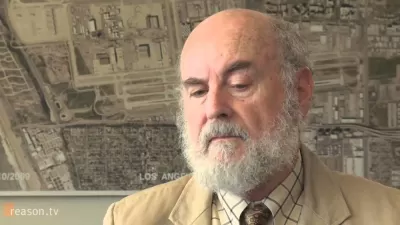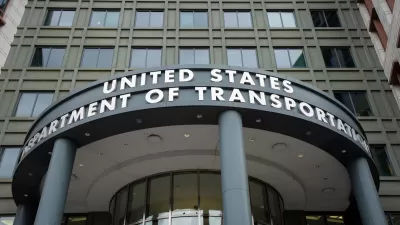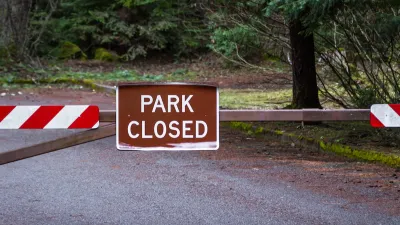Everybody knows that most, if not all, of downtown businesses' customers arrive by car. So it's intuitive to try to come up with a way to encourage drivers - who normally wouldn't venture downtown - to hop into their rides and cruise on down to Main Street to shop for wares. If we could do this, just think of all the new business we'd be stimulating! In continuing with this logic, it's also a given that it's impossible for would-be customers to actually get to downtown without the essential attaché to driving, gasoline. So, isn't it therefore intuitive to suggest that if cities were to give away a little bit of gas to each customer – you know, to kind-of thank them for their generosity - then customers would find an overwhelming incentiv
Everybody knows that most, if not all, of downtown businesses' customers arrive by car. So it's intuitive to try to come up with a way to encourage drivers - who normally wouldn't venture downtown - to hop into their rides and cruise on down to Main Street to shop for wares. If we could do this, just think of all the new business we'd be stimulating! In continuing with this logic, it's also a given that it's impossible for would-be customers to actually get to downtown without the essential attaché to driving, gasoline. So, isn't it therefore intuitive to suggest that if cities were to give away a little bit of gas to each customer – you know, to kind-of thank them for their generosity - then customers would find an overwhelming incentive to come downtown and happily spend their money at restaurants and stores? Of course gas is a commodity with an intrinsic value associated with it, but cities have to step up somehow, right? And if it just seems going too far to give gas away for free, then how about subsidizing gas so that it costs next to nothing? Start out with just main street, but if things go well, then offer more free gas on side streets too. Eventually people will be so accustomed to getting free, or practically free, gas when they come downtown, that paying the market rate for gas will be a silly hiccup in stuffy Keynesian theoro-babble. It's really not too bad a plan since the cost to the city for gas can be spread across all municipal taxpayers. What do you think?
Ok, look, I'm sorry if you're pulling your hair out right now in fury. Perhaps I should have saved this post for April 1st, but I just couldn't help myself. Do me a favor and go back to the previous paragraph and, every time you see the word "gas", replace it with "parking". I'll wait here....Done? Good, then let's all now have a little laugh and be friends again, shall we? What you should now get is the gist of the transportation industry's surfacing contemporary perspective on the true cost of parking to cities. That is, parking is a commodity and should more closely reflect market-based pricing for the greater good of all citizens. Communicating this perspective is going to be slow, difficult, and painful, because for decades communities, both customers and businesses, have seen free, or practically free, parking as an American right, and as a means of stimulating business at all costs. But if we don't start discussing the real costs involved, we'll never be able to answer these same people's demand for convenient parking. It's a vicious cycle!
The trouble is that free parking is not really free. Highly respected expert - and possible Grand Master of Parking – Donald Shoup explains in his paradigm-shifting book "The High Cost of Free Parking", that on-street parking should be priced to ensure that there is almost always one or two free spaces on each block. If it's any cheaper than this, then all citizens pay the price by incentivizing driving, adding to congestion by encouraging "cruising" for parking spaces, and bringing more cars into contact with other citizens, namely pedestrians and bicyclists. Concurrently, he swiftly demonstrates via several strong precedents how market-based pricing actually improves the vitality of local businesses, rather than harms them (which is the common misconception). Furthermore, when cities require developers to provide exclusive parking for each residential, office, or commercial unit they want to build, these costs inevitably get passed on to tenants, customers, and taxpayers, regardless of whether or not they drive, in such a diffuse way that it is nearly impossible to track. In short, we all pay for free parking. If I'm not clear in my paraphrasing, here's a condensed version written by Mr. Shoup himself to tempt you to further reading the full book.
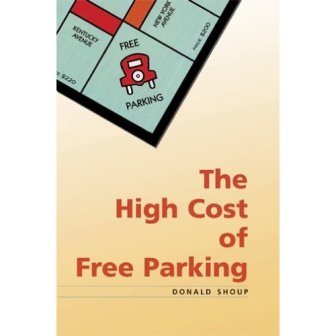
Great Summer Reading!
Since I am always keen to poke holes in the status quo, I particularly enjoy Mr. Shoup's lambasting the standard practice by many engineers of using ITE parking demand rates for urban parking estimates. We force urban developers to build parking using rates measured at suburban sites that give away parking spaces like free ice cream days at Ben&Jerry's (have you noticed there are a few more people there when the ice cream is free?). Now I'm not faulting Ben & Jerry's for a really fantastic community give-back once a year, but if cities gave away fee ice cream year-round, our streets would be jammed all the time and we'd all be getting fatter (no worries though because nothing like that is actually happening). But just like giving away more ice cream won't satiate our demand any time soon, we must recognize that wantonly building more parking is also not a viable solution to downtown parking demand.
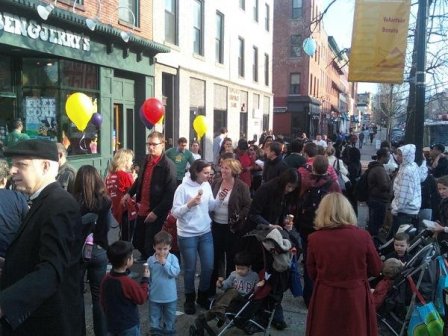
Demand Is High When Something Is Free. Can You Spot The Public Cost?
In areas where alternative transportation options are available, free or cheap parking is a relic of the 20th Century auto-centric mentality where driving gradually morphed from an occasional luxury to a traffic-jammed, optionless nightmare. In a recent paper on the root-source of congestion in Manhattan, local parking expert Bruce Shaller says, "Current economic incentives are skewed in favor of driving since motorists do not incur the cost of delay they create for others, nor do most of them pay for the value of the real estate they park on." The responsible, contemporary practice is to acknowledge the supply/demand characteristics of parking and allow market-based pricing to better rationalize driving in the public mind versus various alternatives, such as transit, biking, or walking. Yes, truth is a jagged pill.
Changing a highly-prized public "right" from free or cheap to market-based is a scary prospect and politically unpopular. But it does not have to be done in draconian fashion, nor imposed in absolute terms. To be effective, we must include the public in the decision making process. It takes judicious minds, patience with education, and a clear, concise message. What is more important to encouraging Main Street shopping, the price of a parking space or actually finding one? Are businesses and their customers willing to continue struggling from now to eternity with no convenient parking, endless circling of blocks "cruising" for a spot, frustratingly wasting time, gas, and energy? Does pricing curb space so that one or two spaces are always available on each block detract from profitability? Can businesses profit from higher turnover of parking spaces? Do cities want to continue inviting more cars onto their streets by forcing developers to build a parking space for every unit of new construction, instead of directing contributions to a municipal fund that can be used flexibly for various transportation improvements such as local shuttles, bicycle facilities, and more efficiently shared public parking? Are adjusted parking revenues put to good use if spent on such improvements? Should the greater public good of promoting a balanced transportation system for all users prevail over a small vocal minority focused on cars? These are the kinds of community-minded questions we must be asking. And we must be prepared with the answers, both in statistical and precedential form.
Change is starting to happen with great success in some places, but there is a long way to go. There are also bound to be some mistakes made along the way. We must rethink the way parking is perceived, more like a valuable commodity we wouldn't ever give away, such as gasoline, rather than a free perk. The sooner we start, the quicker we can rescue ourselves from the glut of cars in our city centers and maxed out parking that frustrates everyone. In the meantime, how about some free ice cream to cool your jets?
Note: Credit for the idea of this post is due to clever Planetizen member johndecember for his great comment here about the parking conundrum in Newport, Rhode Island. Thanks John for the inspiration!

Alabama: Trump Terminates Settlements for Black Communities Harmed By Raw Sewage
Trump deemed the landmark civil rights agreement “illegal DEI and environmental justice policy.”

Study: Maui’s Plan to Convert Vacation Rentals to Long-Term Housing Could Cause Nearly $1 Billion Economic Loss
The plan would reduce visitor accommodation by 25% resulting in 1,900 jobs lost.

Planetizen Federal Action Tracker
A weekly monitor of how Trump’s orders and actions are impacting planners and planning in America.

Wind Energy on the Rise Despite Federal Policy Reversal
The Trump administration is revoking federal support for renewable energy, but demand for new projects continues unabated.

Passengers Flock to Caltrain After Electrification
The new electric trains are running faster and more reliably, leading to strong ridership growth on the Bay Area rail system.

Texas Churches Rally Behind ‘Yes in God’s Back Yard’ Legislation
Religious leaders want the state to reduce zoning regulations to streamline leasing church-owned land to housing developers.
Urban Design for Planners 1: Software Tools
This six-course series explores essential urban design concepts using open source software and equips planners with the tools they need to participate fully in the urban design process.
Planning for Universal Design
Learn the tools for implementing Universal Design in planning regulations.
Caltrans
Smith Gee Studio
Institute for Housing and Urban Development Studies (IHS)
City of Grandview
Harvard GSD Executive Education
Toledo-Lucas County Plan Commissions
Salt Lake City
NYU Wagner Graduate School of Public Service



























